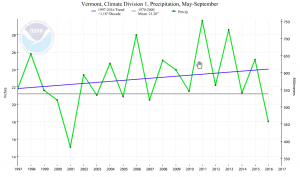Early rains, late rains. Early blight, late blight. Wet spring, dry fall. The variability of Vermont weather means one summer’s typical weather is anomalous in the next.
The crop that is amazing one season could be disappointing the next. Summer 2017 made planting schedules difficult as mid-season rains pelted crops and saturated soils when many farmers wanted to be planting. Lester Farm in New Haven had a successful early crop of melons, which ripened well in the sunny dry weeks of early September, but they’ve sold out now earlier than planned. They’d been expecting to stagger their harvests for a late harvest melon crop but mid-summer heavy rains prevented them from planting their second crop and their melon starts ended up in their compost pile.
Pete’s Greens in Craftsbury, Vermont has also experienced some predicaments due to mid-season rains and early blight this past summer. Farm manager Isaac describes,
…Fungus, bacteria, stuff coming up from the south, blight is pretty common now in Vermont, something we didn’t deal with for our first eight years… Our potato crop is about 50% of what it usually has been. We got tons of rain early on and lost a bunch of seed when we planted it so those crops suffered. Our carrot crop which we plant around July 4 is looking amazing, we’ve had some nice warm dry weather and the rain to give it a big boost and it’s looking super…
Overall, climate impacts in the Northeast show increasing precipitation and increased frequency of intense precipitation events. Heavy rains not only cause soil erosion but also can splash back on plants bringing soil-born diseases in contact with leafy vegetables. Many Vermont farmers cope by planting a diversity of crops and by being nimble in responding to whatever the weather brings.
Farm managers like Isaac have years of experience under their belt so are ready to optimize the resources, crops, green manures, planting and harvesting methods on their fields so that they can continue to meet their expanding regional market for local organic vegetables.
The impacts of climate change have become the back drop to other pressures farmers face including markets, pricing, and pleasing customers. Managing them all is part of the job.
« Adapting Farm Management to a Changing Climate: Butterworks Farm – part II Cover Crops for Climate Smart Farming »

